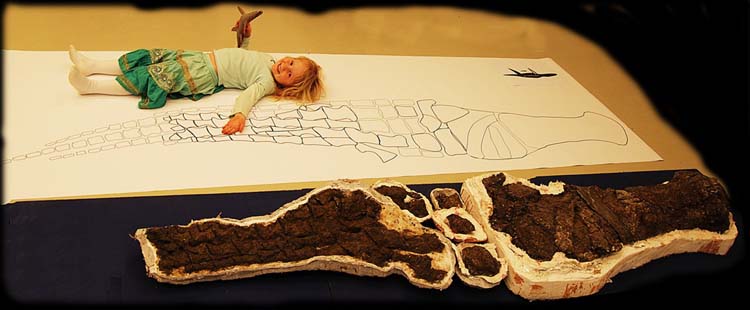from the 2007 season has been released by the University of Oslo. You can
find more information, and images from the expeditions on the University
web site.

The news is, of course, dominated by the large pliosaur, which is reliably estimated as 15 meters long. The paddle alone is 3 meters long. This makes it much the same size as the Monster of Aramberri. The sheer size and power of these animals is astonishing.
Pat Druckenmiller tells me that they have a fair amount of material, mainly postcranial from this specimen. This includes a complete coracoid, several huge dorsal and cervical centra, some with good neural arches, lots of ribs and gastralia; and of course the paddle. Unfortunately they don't have a complete jaw symphysis. The teeth are trihedral in section, as reported previously. Most of the skull and a portion of the body was lost by erosion. Judging from the images on the University of Oslo web site, the bones of this specimen are badly weathered and fragmented. Preparation and consolidation will be a major problem.
A second specimen, probably of the same species, has also been located.
A long-necked plesiosaur, consisting of a complete pelvic girdle, femora, and metatarsals, ribs and about 20-30 vertebrae has also been collected. This is in rather better condition than the pliosaur. The team also collected a partial ichthyosaur skeleton, and it will be interesting to find out if this shows any signs of predation damage. Such evidence is common on the bones of Oxford Clay and Kimmeridge Clay plesiosaurs.
The specimens have been found in a formation of limited stratigraphic range. The dating is still uncertain, and may be Kimmeridgian or Volgian. Jørn Hurum has told me that they are trying to raise funding for absolute dating using Rh/Os. That's something we will await with interest. If the date is Volgian it represents potentially a very significant advance in our knowledge of the evolutionary history of plesiosaurs. Very few specimens from this Stage have been described and only one genus and species, Brancasaurus brancai has been erected. The recent discovery from Speeton almost certainly represents a different genus and species, and there are reports of at least one other Speeton Clay plesiosaur. This still leaves a huge gap in our knowledge.
40 marine reptiles from such a limited area makes this one of the most significant marine vertebrate localities anywhere in the world. Although many more specimens have been found in classic localities such as the Oxford Clay around Peterborough, those discoveries were made over a long period, and were possible because enormous volumes of clay were being excavated by hand. There are dozens of brick pits in the Peterborough area, some of them more than a mile long and half a mile wide, and most of London is built from bricks made from the excavated clay. On Svalbard the specimens are lying on the surface. The absence of vegetation means that the geology is fully exposed when not covered by snow, but nevertheless this is a very high concentration.
We will all await developments with keen interest.